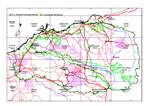Click on images
to enlarge


, Habit 4, BRM 8443, ADJUSTED RICHARD WOODMAN_sml.jpg)
Photographer: B.R. Maslin
, Phyllode nervation, BRM 8437, ADJUSTED RICHARD WOODMAN_sml.jpg)
Photographer: B.R. Maslin
, flowers, Karratha, 7 May 2006, BRM ADJUSTED BY J. FIELD_sml.jpg)
Photographer: B.R. Maslin
, pods (near mature), BRM 8657, ADJUSTED RICHARD WOODMAN_sml.jpg)
Photographer: B.R. Maslin
, BRM 8657, lab photo by Fiona McCallum ADJUSTED_sml.jpg)
Seed from one herbarium voucher. Scale in mm. Photographer: F. McCallum.
Botanical name
Acacia sphaerostachya E. Pritzel, Bot. Jahrb. Syst. 35: 305 (1904)
Description
Dense, spreading, glabrous, slightly resinous (but not sticky) shrubs 1-2.5 m tall and up to 3 m across, branching near the base. Bark light to mid-grey, smooth. Branchlets marked with fine, non-resinous ribs. Phyllodes asymmetrically lanceolate to narrowly elliptic, the upper margin convex, broadest near or below the middle, 2.5-5 (-6) cm long, (3-) 4-7 (-10) mm wide, very fine longitudinal wrinkling when dry, normally rather wide-spreading, commonly shallowly recurved (at least towards the apex) but ranging from straight to prominently recurved or sometimes shallowly sigmoid, slightly shiny, mid-green to dark green; longitudinal nerves numerous, parallel with a few sometimes anastomosing, nerves mostly very indistinct (obscured by surface wrinkling when dry) with 1-3 more evident than the rest; marginal nerves discrete and narrow; apex acute to acuminate, terminated by a small, thickened, blunt, conical point. Inflorescences simple, 1 or 2 in axils of phyllodes; peduncles (6-) 9-20 (-25) mm long; spikes showy, obloid to shortly cylindrical, 7-15 (-20) mm long, bright light golden, the flowers not especially densely arranged. Flowers 5-merous, the buds sub-acute; calyx very shortly dissected into broadly triangular lobes. Pods (few seen) linear to narrowly oblong, flat, not or scarcely raised over or constricted between seeds, 6-8.5 cm long, 5-7 mm wide, erect, coriaceous-crustaceous to sub-woody, valves at least sometimes strongly recurved following dehiscence, straight, longitudinally nerved (some nerves anastomosing), brown, sub-uncinate; margins slightly thickened. Seeds (few seen) longitudinal to longitudinally oblique in pods, seated in shallow but distinct chambers separated by narrow partitions, obloid to ellipsoid, 6-7 mm long, 3-3.5 mm wide, compressed, dark brown but pleurogram bordered by a narrow band of yellowish tissue just prior to maturity, slightly shiny; funicle flat, white, gradually expanded into a ±conical, white aril.
Characteristic features
Glabrous shrubs. Phyllodes mostly 2.5-5 cm long and 4-7 mm wide, asymmetrically lanceolate to narrowly elliptic, the upper margin convex, commonly shallowly recurved (at least towards the acute to acuminate apex), longitudinal nerves indistinct (obscured by fine surface wrinkling when dry). Spikes obloid to shortly cylindrical, showy (bright light golden), flowers sub- densely arranged; peduncles mostly 9-20 mm long, as long as or longer than the spikes. Pods erect, linear to narrowly oblong, flat, coriaceous-crustaceous to sub-woody, longitudinally nerved, valves normally recurved following dehiscence. Seeds with a ±conical, white aril.
Distribution and ecology
Northwest Western Australia where it is largely confined to the Pilbara but does occur northwards to the vicinity of Wallal Downs Station (between Port Hedland and Broome). Within the Pilbara it has a scattered distribution, mostly in the northern and western portions of the region, with most occurrences between Karratha and the general vicinity of Port Hedland; there are outliers in a few places, e.g. near Wittenoom and from Cane River Station, southeast of Onslow. Occurs on plains in (stony) red sand or loam with A. ancistrocarpa and A. stellaticeps over spinifex.
Flowering and fruiting period
It is likely that flowering is related to the timing and intensity of rainfall. The main flowering flush appears to occur from April to June, however, some flowering as been recorded in February - March and October - November. Pods with mature seeds have been collected in October.
Variation
Being of hybrid origin there is a reasonable degree of variation in the phyllode size and degree of curvature, and in the length of the spikes.
Taxonomy
This species is almost certainly a hybrid between A. stellaticeps (small phyllodes, flowers in round heads) and A. ancistrocarpa (long phyllodes, flowers in cylindrical spikes). The two putative parents and A. sphaerostachya have been recorded as growing together in a number of places. Specimens from the Cossack-Roebourne area with somewhat similar-looking phyllodes to those of A. sphaerostachya could possibly represent hybrids between A. stellaticeps and A. arida , or A. stellaticeps and A. trachycarpa (see A. stellaticeps for discussion).
Notes
Showy when in flower but unlikely to be a suitable horticultural plant unless reproduced by cuttings (little seed is produced).
It is of interest to note that this relatively uncommon hybrid species was also described by both Domin (1926, as A. patellaris) and and Blakely (1928, as A. glabripes), based on collections made by E. Clements from between the Ashburton and De Grey Rivers. However, the name A. sphaerostachya has precedence because it was described (by E. Pritzel) more than 20 years earlier, in 1904. Pritzel based his description on a plant collected by his colleague and travelling companion, L. Diels, from near Roebourne in 1901. Diels also collected a narrow phyllode form of the species which Pritzel named as A. sphaerostachya var. angustior, however, this entity is now considered to be part of the normal range of variation for A. sphaerostachya.
Conservation status
Not considered rare or endangered.
Origin of name
The botanical name is from the Greek sphaira (ball) and stachys (flower-spike) referring to the shape of the inflorescence; however, as can be seen from the description above the flowers are arranged in obloid to cylindrical spikes so the species name is not a particularly appropriate one.
References
Domin, K. (1926). Acacia. Bibliotheca Botanica 89: 249-276.
Maiden, J.H. and Blakely, W.F. (1928). Descriptions of fifteen new Acacias and notes on several other species. Journal and Proceedings of the Royal Society of New South Wales 60: 171-196.
Pritzel, E. (1904). Acacia. Fragmenta Phytographiae Australiae Occidentalis 35: 276-314.
